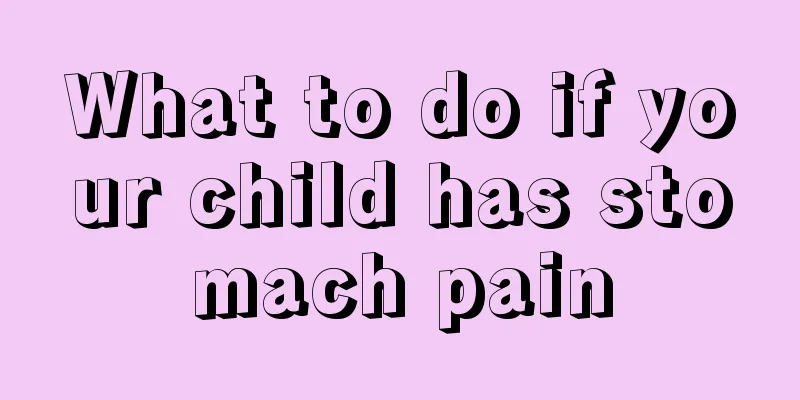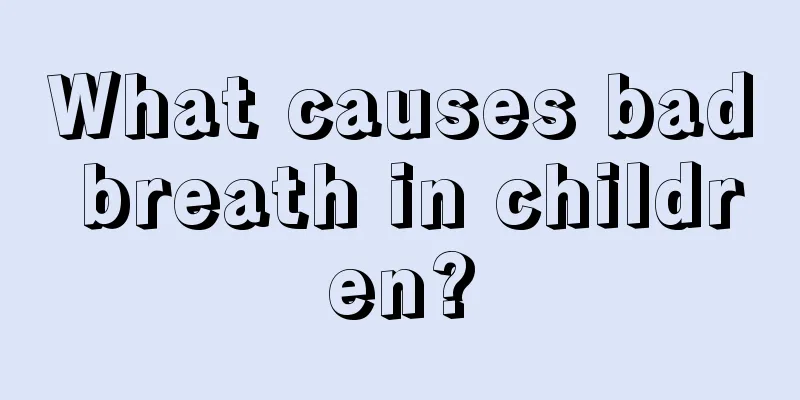What to do if your child has stomach pain

|
Children's development is still immature, and once they catch a cold or fever, the condition will be more serious. Parents take meticulous care of their children, but there are still times when they are negligent. For example, stomachache in children is a very common phenomenon, but there are many reasons for it. It may be caused by the baby's upset stomach, or it may be caused by bacteria in the stomach. To help children relieve pain and help babies grow healthily, let's take a look at several different ways to deal with children's stomachaches. 1. Ascariasis When the environment changes or the child has a fever, diarrhea, hunger or eats spicy food, he or she will suddenly have abdominal pain. The child will cry, roll on the ground, bend over, sweat, and look pale. The abdominal pain is most severe around the navel. It is often accompanied by vomiting, and even roundworms may be vomited out. Abdominal pain can be relieved or even disappear on its own. The pain may occur for several minutes each time, may occur every other day, or may occur several times a day. In recent years, there are many new symptomatic drugs with high efficacy and few side effects, such as levamisole, mebendazole, tetramisole, etc. Children with ascariasis can take these drugs under the guidance of a doctor. Prevention is the key. Vegetables should be washed and cooked, fruits should be washed and peeled, do not drink raw water, and wash hands before and after meals. Keep your nails trimmed 2. Acute appendicitis At first, the child feels pain in the stomach or around the belly button, which turns into pain in the lower right abdomen after a few hours. Pressing the right lower abdomen of a child with your hand will intensify the child's crying. The child is often accompanied by symptoms such as nausea and vomiting, and then has a fever, and the body temperature can rise to around 39°C. The abdominal pain is usually not severe, but the child often lies in bed with his right leg curled up or walks with a bent back. If the child cannot express the pain in words, his crying will be different from usual, and he will curl up his body and break out in cold sweats. If the baby cries for more than 3 hours, parents should suspect the possibility of appendicitis. Appendicitis in children develops quickly. If it persists for a long time, appendicitis perforation may cause purulent peritonitis, which may endanger the child's life. Therefore, if a child is found to have the above symptoms, he or she should be sent to the hospital as soon as possible. 3. Incarcerated hernia The child may experience intermittent crying, abdominal pain, bloating and vomiting. A swelling may appear on the inner side of the groin when standing or straining to defecate, or only one side of the scrotum may become enlarged. This condition may recur after treatment by a doctor. Abdominal pain may occur when children cry, cough, laugh, sneeze, or strain (for example, when defecating) which increases abdominal pressure and causes the intestines to move into the groin or scrotum. Umbilical hernia and inguinal hernia are the most common hernias in children. Umbilical hernia rarely becomes incarcerated, and most abdominal pain is caused by incarceration of inguinal hernia. The child must be sent to the hospital for treatment in time. 4. Gastrointestinal growing pains in children Some children will experience inexplicable paroxysmal abdominal pain, and the cause cannot be found after multiple examinations. Medication for treating intestinal spasms and anthelmintics is also ineffective. In fact, this abdominal pain may be a normal physiological phenomenon, medically known as "gastrointestinal growing pain in children." The main feature of growing gastrointestinal pain in children is that it recurs over a certain period of time. Each pain is short, generally not exceeding 10 minutes. The main location of abdominal pain is around the abdomen, followed by the upper abdomen. The pain comes and goes, and recurs repeatedly. The abdominal pain can be mild or severe. In severe cases, the child may cry and roll for a long time. The stomach is slightly hard, and the whole abdomen is soft during intervals. It may be accompanied by vomiting, but the child is in good spirits after vomiting. The pain has no certain regularity and the degree of pain is also inconsistent. Mild cases are only abdominal discomfort, while severe cases are intestinal colic. The child is in unbearable pain and can hear "gurgling" bowel sounds. However, this pain can be relieved quickly, and the child's mental state, diet and activities will return to normal after the pain is relieved. Growing gastrointestinal pains in children generally do not require treatment. If the pain is severe, you can apply hot compress or massage the Zusanli acupoint and abdomen, which can help relieve the pain. However, there are many causes of abdominal pain in children, and a doctor must make a clear diagnosis and rule out other diseases before confirming that it is gastrointestinal growing pain. This disease is a simple functional change and a non-organic lesion, so the prognosis is good and most cases can heal themselves. If your child is given an appropriate amount of belladonna tincture orally under the guidance of a doctor, the pain can be relieved quickly. 5. Bacillary dysentery The onset is often sudden, with a fever of 39°C or even higher, increased frequency of bowel movements, paroxysmal abdominal pain before diarrhea, and increased "gurgling" sounds in the stomach, but no obvious abdominal distension. The sick child was severely dehydrated, had poor skin elasticity, and suffered from general fatigue. This disease is more common in summer and autumn, mainly due to bacterial infection caused by neglect of food hygiene. When sending children to the hospital for treatment, parents can also provide comprehensive care to help the children relieve pain. The sick children must be isolated, and tableware can be disinfected by boiling in water for 15 minutes. Toys given to children can be made of wood or plastic which are easy to disinfect. The child's bed sheets and blankets can be exposed to sunlight for 6 hours for disinfection. The child should rest in bed. When a child has abdominal pain, you can put a hot water bottle on his abdomen, but be careful not to make the water temperature too high to prevent burns. If infants and young children have a rapid and urgent bowel movement, you can let them defecate in their diapers instead of sitting on the toilet to prevent anorectal prolapse. Wash your child's buttocks with warm water after each bowel movement, and apply 5% tannic acid ointment to the skin around the anus. If you have rectal prolapse, you can use gauze or soft toilet paper coated with Vaseline, support the prolapsed anus, massage it gently while pushing it upwards to restore it. If your child is vomiting frequently, he or she may need to fast for a short period of time, and the doctor may give your child intravenous fluids. Parents can feed their children less greasy liquids, such as lotus root powder, soy milk, etc. Once your condition improves, you can eat as soon as possible. At this time, you can feed your child semi-liquid food with little residue and easy to digest, such as oatmeal porridge, steamed eggs, boiled noodles, etc. Milk can easily cause diarrhea and bloating, so don't feed it to your child for the time being. Give your child more water. In the later stages of recovery, try to stimulate the child's appetite. You can also let him take digestive enzyme drugs such as pepsin half an hour before eating, and add nutrition and protein to his diet. Start with small meals and gradually increase the amount to prevent indigestion. The child's diet should be arranged reasonably. In addition to avoiding raw, cold, indigestible and greasy food, in order to improve the child's nutritional status in the short term, it should be combined with the child's usual eating habits, and attention should be paid to improving the color, aroma, taste and diversity of the food to stimulate his appetite. 6. Chronic gastritis It is often recurrent paroxysmal abdominal pain, which is often irregular, with pain mainly above and around the navel, often accompanied by typical manifestations such as upper abdominal tenderness, anorexia, weight loss, vomiting, and heartburn. Most of the sick children have a history of unclean diet, uneven hunger and fullness, or a preference for raw and cold food. There is no specific treatment for chronic gastritis in children. The treatment for chronic gastritis in children should be based on a combination of diet therapy and drug therapy. In addition to actively cooperating with doctors for drug treatment, parents can also start by adjusting their children's daily diet. The principle of dietary therapy is to maintain the nutritional intake of children to ensure their normal growth and development and prevent nutritional imbalance. Parents can arrange easily digestible food according to the child's age and living habits, and feed the child small meals frequently to prevent the child from eating irritating food, drinks, etc. Children with poor eating habits, recurrent upper abdominal pain or periumbilical pain should undergo fiber gastroscopy as soon as possible to confirm the diagnosis. The diagnostic positive rate of fiber gastroscopy for pediatric gastritis and peptic ulcer is much higher than that of gastrointestinal barium meal examination. In the past, it was believed that chronic gastritis was rare in children. However, because children nowadays tend to eat more "junk food" and parents do not pay attention to cultivating their children's good eating habits, the incidence rate is increasing. This disease is one of the main causes of recurrent abdominal pain in children. 7. Habitual abdominal pain When all possible acute diseases and ascariasis are excluded, any recurrent abdominal pain that cannot be diagnosed may be habitual abdominal pain. It usually starts around the age of 4. The pain often occurs after breakfast or meals. When asked where the pain occurs, the child often points to the navel. There is no fever or diarrhea. The pain was not severe and it went away after 10 to 20 minutes, as if nothing had happened. But the next day the child complained of stomach pain again. We went to the hospital for a check-up, but no substantial lesions were found, and no worm eggs were found in the stool either. Although this disease has not yet been included in general textbooks, it does exist among young children. Research by foreign scholars has also shown that similar abdominal pain not only exists, but is also quite common. It is speculated that this is because the child's internal organs are too sensitive and they mistake gastrointestinal movements for abdominal pain. It may also be due to constipation, because for many children, the abdominal pain disappears after defecation. At present, there is no special treatment for habitual abdominal pain. Try to prevent your child from constipation and let your child eat more fruits, yogurt and other foods. When the pain occurs, press the "Zusanli" point with your thumb, which can quickly relieve the pain. Be careful not to press with your fingernails to avoid hurting the skin. 8. Acute mesenteric lymphadenitis The vast majority occur between the ages of 3 and 10, with boys accounting for 57%, and the peak incidence is in children under 7 years old. The disease often occurs during the course of acute upper respiratory tract infection or secondary to intestinal inflammation. First there is fever, then abdominal pain. The location of abdominal colic may be diffuse or vary depending on the location of the inflamed lymph nodes, but it is most common in the right lower abdomen. The location and intensity of abdominal pain can vary. Take your child to the hospital as soon as possible. 9. Abdominal urticaria It is related to children eating foods containing allergens such as fish, shrimp, eggs, etc., and umbilical pain often occurs at the same time as skin itching, accompanied by vomiting and diarrhea. If your child has an allergic constitution, you should try to avoid eating foods that are prone to allergies. If you have abdominal pain, you should take oral anti-allergic drugs as prescribed by the doctor, and the abdominal pain can be relieved. The above nine different coping measures for children's stomach pain should be read carefully. They are quite effective in urgently relieving children's symptoms, and parents can take note of them. However, the road to children's growth is relatively muddy, so parents must lay a good foundation for their children's health so that it will not be difficult for them to grow up healthily. |
<<: What to do with stomatitis in children
>>: Introduction to the growth and development rules of children
Recommend
Does your baby have a dent on his head?
A sunken baby's head is a very common disease...
What causes children to often have oral ulcers?
Children often get oral ulcers because of lack of...
What should children eat if they have lung heat and cough?
Children will always encounter problems of one ki...
Children's cough acupuncture points
When a baby has cold symptoms, parents are reluct...
Does a three-month-old baby need an injection if he has a fever?
Good health has always been the most important pa...
How often should newborn bottles be sterilized?
We all know that most newborns drink milk powder ...
Why do children always sweat under their armpits when sleeping at night?
It is not uncommon for children to sweat under th...
How to improve children's physique?
As children grow up, they will suffer from sympto...
Early symptoms of psoriasis in children
Psoriasis is a common skin disease in our human b...
What to do if your five-year-old baby has a bad stomach
A 5-year-old baby may have poor gastrointestinal ...
What to do if your baby has a thick nasal discharge or stuffy nose?
It is normal for babies to have a runny nose, but...
What are the clinical manifestations of infantile head hematoma?
Many children have swollen heads after birth, whi...
Is it normal for babies to foam at the mouth?
It is generally normal for babies to foam at the ...
What to do if your baby has indigestion
Our baby’s health always comes first in every fam...
Symptoms of viral fever in children
It is very common to catch a cold and a fever whe...









